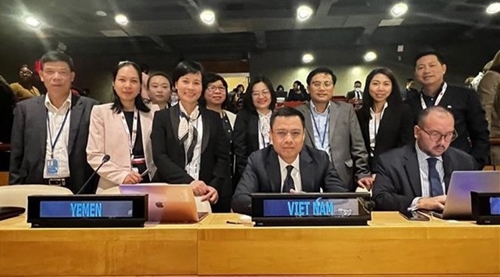    |
 |
|
Ambassador Dang Hoang Giang (front, left) and other members of the Vietnamese delegation at the Intergovernmental Conference on Marine Biodiversity of Areas beyond National Jurisdiction in New York |
The agreement under the U.N. Convention on the Law of the Sea (UNCLOS) 1982 was adopted at the Intergovernmental Conference on Marine Biodiversity of Areas beyond National Jurisdiction in New York on June 19.
Most of the U.N. member states have applauded and voiced strong support for the adoption of the high seas treaty, and also shown their intention to sign and ratify the deal soon so that it can take effect early and be implemented fully and effectively.
Cuba, representing the group of developing countries, described the adoption as a success of multilateralism and developing countries thanks to their tireless efforts and strong solidarity.
Addressing the conference, Ambassador Giang, Permanent Representative of Vietnam to the U.N., affirmed that the success reflects the conference’s strong commitment and determination to achieve an instrument for conserving and sustainably using marine biodiversity of areas beyond national jurisdiction.
The treaty will further consolidate the UNCLOS 1982 – the “constitution of the oceans” and a comprehensive legal framework for all sea-related activities, promote multilateralism, be a new landmark in the development of international law, contribute to the implementation of the U.N. Decade of Ocean Science for Sustainable Development, and help reach Sustainable Development Goal 14 on conservation and sustainable use of the oceans, seas, and marine resources, he went on.
The U.N. adoption of the agreement was highly meaningful, especially for those who directly engage in the negotiations, including the inter-sectoral delegation of Vietnam led by the Ministry of Foreign Affairs, since it came as a result of a long and complicated negotiation process.
The UNCLOS 1982 stipulates the freedom of navigation and fishing on the high seas beyond exclusive economic zones of states, and that seabed resources on the continental shelf of a state are the common heritage of mankind. It also outlines a mechanism for licensing and distributing benefits from seabed mining on the high seas, but has yet to have a similar mechanism for marine genetic resources.
The high seas treaty, comprising 17 chapters with 76 articles and two appendices, develops the UNCLOS on this aspect. It is the third treaty to enforce the UNCLOS 1982, following the U.N. Fish Stocks Agreement and the Agreement on Part XI of the UNCLOS.
Source: VNA